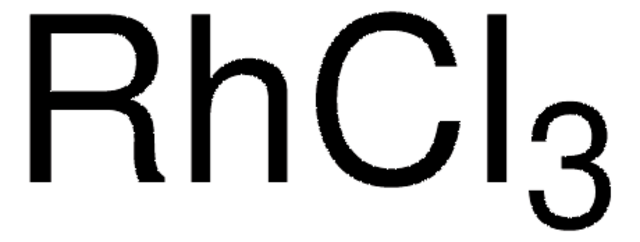463779
Cloreto de rutênio (III)
99.98% trace metals basis
Sinônimo(s):
Trichlororuthenium hydrate, Ruthenium trichloride
About This Item
Produtos recomendados
Nível de qualidade
Ensaio
99.98% trace metals basis
Formulário
powder and chunks
adequação da reação
reagent type: catalyst
core: ruthenium
Impurezas
≤250.0 ppm Trace Metal Analysis
cadeia de caracteres SMILES
O.Cl[Ru](Cl)Cl
InChI
1S/3ClH.H2O.Ru/h3*1H;1H2;/q;;;;+3/p-3
chave InChI
BIXNGBXQRRXPLM-UHFFFAOYSA-K
Procurando produtos similares? Visita Guia de comparação de produtos
Descrição geral
Aplicação
- As a precursor to prepare ultralow Ru loaded graphene aerogel that exhibits electrocatalytic performance in the hydrogen evolution reaction (HER), oxygen evolution reaction (OER), and oxygen reduction reaction (ORR).
- As a dopant to prepare Ru-doped TiO2 electron transport layer for mesoscopic perovskite solar cell by spin-coating technique. This helps to enhance photoconversion efficiency and air stability.
- To fabricate ultra-uniform Ru nanocluster catalyst via small-molecule self-assembly pyrolysis method. These catalysts exhibit excellent hydrogen evolution activity in Zinc air batteries under all pH conditions.
Outras notas
Palavra indicadora
Danger
Frases de perigo
Declarações de precaução
Classificações de perigo
Acute Tox. 4 Oral - Aquatic Chronic 2 - Eye Dam. 1 - Skin Corr. 1B
Código de classe de armazenamento
8A - Combustible corrosive hazardous materials
Classe de risco de água (WGK)
WGK 3
Ponto de fulgor (°F)
Not applicable
Ponto de fulgor (°C)
Not applicable
Equipamento de proteção individual
Eyeshields, Faceshields, Gloves, type P3 (EN 143) respirator cartridges
Escolha uma das versões mais recentes:
Já possui este produto?
Encontre a documentação dos produtos que você adquiriu recentemente na biblioteca de documentos.
Os clientes também visualizaram
Artigos
Hydrogen is one of the most important resources in providing food, fuel, and chemical products for our everyday life. Sustainable catalytic hydrogen production from bioethanol has gained significant attention in recent years due to globally diminishing fossil fuel supplies, which have necessitated the search for new chemical feedstocks.
Nossa equipe de cientistas tem experiência em todas as áreas de pesquisa, incluindo Life Sciences, ciência de materiais, síntese química, cromatografia, química analítica e muitas outras.
Entre em contato com a assistência técnica











